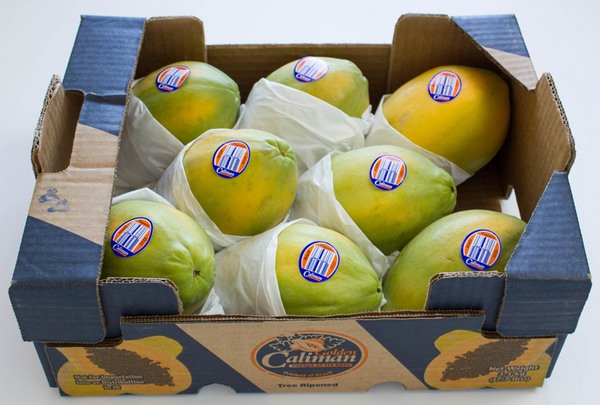Nowadays, consumers are used to being able to buy many fruit and vegetable items all year long. Although in-season much is grown domestically, some fruit and vegetable varieties are almost exclusively imported. Papayas are one of these items and 97.7 percent of consumption is grown outside the US, according to the USDA. What is the impact of the coronavirus on availability of tropical and exotic items that are mostly sourced in South America?
 Papayas from Brazil.
Papayas from Brazil.
Air freighters from Brazil
“Our large papaya imports from Guatemala and Mexico are not significantly affected as they arrive by ocean and truck,” says Andres Ocampo with HLB Specialties. However, for papayas from Brazil it’s a different story. “Until last week, we were bringing them in by air.” The company had been able to fly its products on - sometimes empty - passenger planes. “With the number of passenger flights continuing to be reduced, HLB Specialties is now being forced to switch to freighters. The cargo airline HLB has been using flies from the State of Sao Paulo in Brazil to Miami on a regular basis, about five times a week. “We’ve been using this alternative to maintain fruit incoming, albeit at a higher cost,” said Ocampo. “We have also explored charter flights from Brazil that exclusively fly our product, but the distance (fuel needs) makes it too expensive to absorb for the products we handle. Switching to ocean freight from Brazil is not feasible due to transit times.”
Lower volumes coming in
HLB’s strategy is to continue looking for opportunities to bring the fruit by air in the most logistical and cost-effective way. From Brazil, that means by freighters for now, although the volumes brought in are lower. “It’s a combination of factors, but since freighters don’t fly as frequent and there are not as many freighter airlines out there, we are dealing with lower space capacity,” mentioned Ocampo. “Because of limited availability, costs for freight are much higher and on top of that, we are seeing a slight decrease for demand on the market. This situation is very fluid and every week, we have to adapt to new carriers and transit routes.”
 This Publix supermarket in Plantation, FL. had no papayas left.
This Publix supermarket in Plantation, FL. had no papayas left.
Yellow pitahayas from Ecuador will gap
Another product HLB sources in South America is yellow pitahaya, grown in Ecuador. As this is one of Latin America’s countries hardest hit by the coronavirus, there are very stringent restrictions for movement of people. Packing houses have effectively shutdown and as a result, no new product is being shipped. “The volumes currently available of yellow pitahaya are from older arrivals and the last shipments that arrived by boat. Given that Ecuador is the main supplier of yellow pitahaya to the US, it’s likely we will see a gap at the store level in the next few weeks,” said Ocampo. Goldenberries are sourced in Colombia and although it is challenging to get air space, there is at least some level of flights available. “The Colombian government has special rules that allow food operations to continue working, so even though volumes have been affected, there is still movement of product out of the country.”
 North Bay farm in Guatemala.
North Bay farm in Guatemala.
Smooth logistics from Guatemala
Guatemala is another key sourcing country for US importers. “Our rambutan season out of Guatemala will be starting soon, but we don’t expect to have major issues as the market is serviced by air cargo freighters,” said Ocampo. Guatemala is also the US number one supplier of snow peas and sugar snaps. “Right now, our import season is nearly all vegetables,” said Brian Klumpp with North Bay Produce. “We bring in snow peas, sugar snaps and French beans from Guatemala, but there are no supply issues since everything arrives by boat. It’s a 3-day trip to the US and the product goes into our Miami warehouse.”
For more information:
Andres Ocampo
HLB Specialties
Tel: (+1) 954-475-8808
andres@hlbspec.com
www.hlbspecialties.com
Brian Klumpp, Jr.
North Bay Produce
Tel: 231.492.7457
bmklumpp@northbayproduce.com
www.northbayproduce.com
